- Testing Basics
- Home
- /
- Learning Hub
- /
- Grey Box Testing Tutorial
- -
- April 03 2023
Grey Box Testing Tutorial: A Comprehensive Guide With Examples And Best Practices
Learn what is grey box testing, its significance, techniques, and how to get started with grey box testing.
OVERVIEW
Grey box testing is the technique to debug and evaluate the vulnerabilities of software applications. In such a method, the testers have only limited knowledge of the internal structure or components of the software applications under test.
In the Software Development Life Cycle (SDLC), testing is the crucial phase that verifies the quality of the software application. In this development cycle, different software testing techniques like a black box and white box testing are used to evaluate the performance and function of software applications and ensure their quality.
Black box testing involves validating the software without knowledge of its internal workings. In contrast, white box testing involves validating software with a full understanding of its internal workings.
However, in some cases, having full knowledge of the internal workings of the software is impractical or impossible. This is where grey box testing comes in, combining white and black box testing elements to help debug and verify the functionality and behavior of software applications, such as code execution, database access, and server configuration.
It allows testers to identify defects that may not be visible in black box testing while providing an external perspective on the software application under test.
What is Grey Box Testing?
Grey box testing involves verifying the functionality of the software application and identifying vulnerabilities. Here, the tester is partially aware of the application's internal workings and components. However, they perform the grey box test based on their access to design documents, internal coding, database, and information about the requirements. Grey box testing evaluates web applications, performs integration and penetrating testing, tests business domains, conducts security assessments, etc.
QA creates test cases and efficiently executes them using partial information on the data structures and algorithm. This allows finding context-specific errors in web applications using the test cases, as it has all the steps presented before the test initiation. Such errors only occur under specific conditions or in a particular context. For example, an error might occur when an end-user tries to submit a form with a specific input type, but the error does not occur with other input types.
Grey box testing can be implemented in many ways, including penetration and integration testing. Such tests are non-obtrusive for the testers, meaning they do not disrupt the software application's normal functioning while testing occurs. Its primary focus is testing the interactions between different software application modules and finding any vulnerabilities attackers could exploit.
For example, if a tester finds any defects in the software application and makes code modifications to fix it, they perform retesting in real time. In this process, all levels of software applications, like the user interface or display layer, the business logic layer, the data storage layer, and the core code structure of the software, are tested. Like real-time testing, grey box testing focuses on testing all levels of any complicated software application to enhance test coverage.
Why Grey Box Testing?
Grey box testing is an integral part of the Software Testing Life Cycle (STLC) and is performed during the testing phase. In this phase, when the team executes test cases, the grey box test technique is needed to understand the internal workings and verify the functionality and performance of the software application. It is also performed to find errors that are not easily identified by performing black box testing.
While testing the software application, grey box testing helps to identify the component or part of the software application with major performance issues. However, testing done in real-world scenarios gives accurate information on the test. You can simulate real-world scenarios like data interaction or network connectivity with a grey box test.
Grey box tests also identify security vulnerabilities within the software application, like SQL injection attacks. This can be done by analyzing the code (the software application's source code) and logs (records generated by the software application that provide information about its behavior and operations).
Thus, grey box testing is required in the testing phase to ensure the software application's quality and lower the risk of bugs post-software application release.
Run your test scripts across real desktop and mobile browsers. Try LambdaTest Now!
Objectives of Grey Box Testing
The main purpose of grey box testing is to find and verify defects due to incorrect code structure and its use in the application. Some of its other associated objectives are mentioned below:
- To improve the quality of the software application that covers functional testing and non-functional testing.
- To save time and effort required to test the software application.
- To test the software applications from the end-user's perspective
Grey Box Testing Example
To understand grey box testing, you must know its practical use that will help you analyze where and when to implement it in the Software Development Life Cycle.
Here are some examples of grey box tests.
Example 1: Suppose you are testing a website. There is an error when you click on a link. Here, grey box testers make changes in the HTML code to fix the error. In such a scenario, you are performing both white and black box testing. For example, the white box test is done while changing the code. This is because testers have access to the internal workings of the website and are making changes to the code based on that knowledge.
However, the black box test is done when the QA validates the change at the front end to test the behavior of the website without knowledge of its internal workings. Thus, its combination overall results in grey box testing. The tester has only partial knowledge of the internal workings of the website under test.
Example 2: Grey box testers analyze the error codes found in the software applications. As they have access to the error code tables, they provide the cause for the error code. For example, while testing a website, if it gets an error code “internal server error 500”, and the cause of this error showing in the table is a “server error,” the tester uses this information to analyze the issue further. It gives the developer details to fix rather than just raising the issue.
Example 3: Grey box testers also evaluate the log files that contain a record of events within a software application, such as errors, exceptions, and warnings. This helps them to find the root cause of the errors and gain insight into the behavior of the software application.
Advantages of Grey Box Testing
Grey box testing helps verify the quality of the software application in many different ways. You should consider its significance in testing to get started. Here are some advantages of grey box tests that give insights into how it benefits software application development.
- It is possible to review the software application’s code, where you can easily detect hidden bugs. In addition, it also provides a way to evaluate software applications’ functionality from the end user's perspective. Thus, with grey box tests, you can detect bugs early in the software application development process.
- With early detection of bugs, developers can fix them quickly. This will help avoid situations where software applications might get complicated and the fixation of bugs becomes costly.
- Optimization of software applications' performance becomes easy. You can identify performance-related issues and inefficiencies in the software application. This can be done by analyzing the application’s log and internal data.
- Grey box tests validate software applications with both a user interface and a backend. You can test the software application from the user's perspective with some knowledge of its internal workings. This will help you to test the software application more comprehensively and find defects that may not be detected from the user interface alone
- Compared with black box testing, grey box testing is a more cost-effective method. This is because it does not require specialized skills and knowledge of the testers. As grey box testers do not need to know the application’s source code deeply, an organization can hire testers with a broader range of skills and lower experience levels.
Disadvantages of Grey Box Testing
Gray box testing can be very useful in testing the functionality of software applications, but it can also have some drawbacks. The following are some drawbacks associated with it.
- In distributed software applications with components at different locations, grey box testing cannot trace a defect back to its source. It is because testers do not have complete knowledge of the internal working of the components of software applications. For example, any defect in one component could cause defects in other components. As the tester cannot access the first component’s internal work, finding the main cause of the issues may be difficult.
- Grey box testers have limited access to the internal structure of the software applications. It makes it difficult for them to transverse all possible code paths. Thus, certain defects may go undetected.
- It is unsuitable for algorithm testing; instead, it focuses on functional testing.
- Creating grey box test cases are complex because testers have limited knowledge of the internal interaction of components of the software application.
White Box vs. Black Box vs. Grey Box Testing
Grey box testing differs from white and black box testing. In white box testing and black box testing, testers have end-to-end knowledge of the internal structure of applications. However, in black box testing, testers are unknown of the internal structure and components of the application.
Compared with grey box testing, testers are typically known only for the internal components of applications but unaware of their interaction and associated function. Thus, grey box tests are a hybrid of black and white box testing, also called translucent box testing.
The table below defines the difference between white box, black box, and white box testing.
| White Box Testing | Black Box Testing | Grey Box Testing |
|---|---|---|
| Testers fully know the internal structure, design, and component and their interactions in the software application. | Testers do not know about the internal structure, design, components, and their interaction in the software application. | The testers partially know the internal structure, design, components, and their interaction in the software application. |
| Testers should have good programming skills. | Testers do not require high-level programming skills. | Testers should have basic programming skills. |
| Its execution is highly time-consuming. | Its execution is comparatively less time-consuming. | Its execution is less time-consuming than white box testing. |
| It covers three techniques: Statement Coverage, Decision/Branch Coverage, and Condition Coverage. | It covers six testing techniques: Equivalence Class Partitioning, Boundary Value Analysis, Decision Table, State Transitioning, Use Case Testing, and Cause-Effective Graph/ Graph-Based Technique. | It covers four testing techniques: Matrix, Regression, Orthogonal Array, and Pattern Testing. |
| It has a high level of granularity. | It has a low level of granularity. | It has a medium level of granularity. |
| It is suitable for algorithm testing. | It is not ideal for algorithm testing. | It is not suitable for algorithm testing. |
When to perform Grey Box Testing?
The use of grey box testing varies depending on the software application's requirements, testing goals, level, scope, objective, and tools. For example, it can be performed at stages like acceptance testing and system testing.
Let us see a different scenario where you can run grey box tests.
- You can use grey box tests when testing the interaction between the different components of the software application. It only requires having limited knowledge of how components interact.
- Whenever software applications undergo specific changes in features or updates, a grey box test should be used to verify its functionality corresponding to the changes.
- You can run a grey box test when testing the security of the software applications. It is done by simulating attacks from hackers with limited knowledge of the internal working of the software applications.
- Grey box tests are run to validate the functionality of the database by verifying data schema, data flow, and constraints.
- You can run grey box tests in API testing. It is needed to check the functionality of the APIs and their interaction with the software applications that use them.
What to test in Grey Box Testing?
When running grey box tests, you should know about the software application's different aspects. It will help you understand the key areas that require a grey box test and give a clear path to start with it.
Here are some important aspects that you should analyze while running grey box tests:
- The flow of specific inputs through the software application: Grey box testers identify and test the different inputs, such as user inputs, system inputs, or external inputs, and their source in the software application. The path through which such inputs are entered into the software application to the point they are processed and stored is traced.
- Potential vulnerabilities within an application's security system: Grey box tests validates restricted actions, including accessing sensitive data, manipulating URL and input parameters, injecting code, and brute force attacks.
- Testing expected output for a given set of inputs in software application: Grey box testing validates the output of a software application to ensure its alignment with the Software Requirements Specification. In other words, the tester verifies the actual output of the application with the expected output to find if there are any errors or defects. It will help ensure the software application provides the correct result, meets the end-user requirement, and functions bug-free.
- Identifies poorly structured and broken code paths of software applications: QA tests the applications for the code path intended to handle errors. For this, they create test cases that cause errors to ensure that the error-handling code path is functioning as expected. Correspondingly, a tester in grey box tests checks for the complex conditional statement in an application and creates test cases that perform all possible combinations of inputs and ensure that the code path is functional in all test scenarios.
- The behavior of the conditional loops: You can understand a conditional loop as a programming construct where a block of code is executed repeatedly until a specified condition becomes true. In grey box testing, you can test the behavior of the conditional loop by verifying the code to ensure the condition causing the loops and related action taken within the loop.
- Test access validation: In grey box tests, verify that the user with the correct access can only perform the action for the functions or activity of the software application. For example, the grey box testers test the endpoint to ensure only admin users can make inventory changes.
For example, if a grey box tester tests a web application that allows users to enter information in the forms, they will identify inputs like name, email address, and others. Further, they will trace the path of the inputs through the web application, evaluating how it is processed and stored. During such a process, the tester will detect any defects that could cause unexpected behavior in the web application.
Techniques of Grey Box Testing
Grey box testing can be performed during the testing phase of software application development. There are different techniques you can use to ensure all defects are addressed. Some of those techniques are as follows:
Matrix Testing
It involves creating a risk matrix to prioritize test cases depending on their severity and consequence. A score is assigned to each element or all possible combinations of inputs and parameters of the software application being tested.
Here, “element” refers to the software application's specific features, components, and aspects. For example, you can understand elements as particular functions or modules of software applications or specific user interface elements like a menu option.
The term “combinations” are a specific set of values for any input or parameters of a software application. For example, if the software application has a login function, the password and username fields are input parameters or variables, and different combinations of values are entered for these inputs.
Each element and possible combinations are evaluated based on its severity and consequence and assigned a score in the risk matrix. For this, matrix are created in the form of tables, with each row showing a unique combination of input values/elements and each column showing different parameters/elements.
The score given shows the level of risk associated with elements/combinations and allows testers to prioritize their testing efforts by emphasizing elements with high scores. With this, you can address the most critical issue first and lower the risk to the software applications. This shows different possible combinations/elements and test cases designed for each to ensure all test scenarios are covered.
Regression Testing
It is the technique where any changes or update made to the software application does not impact its existing functionality. It is utilized in grey box tests because it allows testers to identify any potential defects due to the changes done in part of their software application.
You can use the following testing strategies to perform regression testing in a grey box test:
- Retest All.
- Retest Risky Use Cases.
- Retest By Profile.
- Retest Change Segment.
- Retest Within Firewall.
When you perform regression testing, you ensure the stability and reliability of software applications after the changes in the features or updates. This technique makes identifying early bugs possible in a grey box test before they cause any challenges in software application development.
You can run regression tests in automation frameworks like Selenium for your web applications. It supports different browsers and platforms for web testing.
Orthogonal Array Testing
It is a statistical testing technique utilized for selecting the number of test cases that covers a large number of combinations of input parameters/variables of software applications. The techniques of grey box tests combine statistical and exhaustive testing to give comprehensive test coverage with a minimum number of test cases.
This testing technique also covers all possible combinations of input parameters and variables by designing corresponding test cases. It is done using an orthogonal array to identify the variables/input parameters that have more impact on the function of software applications. Then you can create test cases that include all possible combinations of such variables/input parameters.
Here an orthogonal array is a set of columns. Each column has a set of values for the variables/ input parameters. When you choose a value, it should be statistically independent of each other. With this, you can ensure that each combination is covered at least once, lowering the required test cases.
Hence, you can design test cases that consider all variable/ input parameters without running many tests. Thus, this maximizes testing coverage and lowers the time and effort to run tests.
Pattern Testing
It can be performed in software applications that are developed based on a similar programming pattern or structure to previous software application projects. Some examples of patterns this test focuses on include loops, conditionals, function calls, and data structures.
The software applications are likely to have some defects that might have occurred in the previous software applications. With pattern testing, you can quickly identify the flaws in the current software applications.
This technique is used in the grey box tests to improve the efficiency of the test. Here, you can use the knowledge of the internal workings of software applications to design test cases that focus on specific patterns or structures in the code. It helps quickly identify defects related to such patterns as logical inconsistencies and coding errors.
How to perform Grey Box Testing?
There are specific steps to be followed to run grey box tests. Let us explore those steps:
- Make a list of all inputs from the black and white box testing method: You need to identify all the inputs obtained from the white box and black box test. Here the inputs are the command or data given to the software application being tested. It can come from different sources like user inputs, network inputs, or automated test scripts.
- Make a list of all outputs from these inputs: Once you have identified the inputs, you need to identify all the expected outputs from such inputs. For example, if the input is a user request to execute an action in a software application, the expected outputs could include completing the action, an error message if the action is not performed, or an abrupt function if the bug is present. This will help you to get the expected behavior of the software application based on its architecture, design, and specifications and give a baseline for the testing process.
- Make a list of all the key routes: This involves identifying the key path or route that the software application will take during the test. You can determine this path by analyzing software applications’ architecture and design or their expected functions. Here the key route may involve interaction between different software application components, such as the user interface, database, and application logic.
- Identify sub-functions for deep-level testing: In this step, you need to identify the software application's sub-functions (specific parts or components of the software application) that must be tested in detail. You have to break down the software application into smaller components and test them individually to ensure their proper function. You can prioritize these sub-functions based on their importance and criticality to the software application’s overall functionality.
- Make a list of inputs for sub-function: On identifying the sub-function of the software application, you need to make a list of all inputs that can be used to test each sub-functions. You can get those inputs from black and white box testing.
- Make a list of all expected outputs from the sub-function: For each of the inputs for the sub-function, you now need to determine its expected outputs. This will allow the expected behavior of the sub-functions of software applications.
- Run the sub-function test case: In this step, you are required to create a test case or to test each sub-function individually. Each test case should be run according to specified input values and verify that the actual output matches the expected output.
- Repeat steps 4-8 for each additional subfunction: Steps 4-8 are repeated for all the sub-functions identified in step 4.
- Check the reliability of the sub-function result: After executing the test cases, you need to analyze the result. This is required to check whether the sub-function is working accurately or find any defects that require it to be addressed.
- Perform steps 7 and 8 for other remaining sub-function: Steps 7 and 8 are repeated for all the sub-functions tested in step 9 to ensure that they meet the expected results.
Grey Box Testing Tools
Grey box testing can be performed by both manual and automated approaches. In the manual approach, testers use their partial knowledge of the design and architecture of the application to find any issues. Testers perform manual tests to overcome challenges aroused by the issue. Even though it is a time-consuming process, it is an effective approach to identifying hard-to-find bugs.
To reduce the time and effort in grey box tests, automated testing is crucial for specific repetitive tasks and components of applications accessible through APIs, SDKs, and other documentation. It uses automation testing frameworks and tools that make testing more efficient than manual testing.
Let us learn some test tools for grey box tests.
- Selenium: UI test planSelenium is an open-source automation testing framework that tests web applications in browsers. You can use Selenium for cross browser testing to check the application's working across various browsers and versions.
- Appium: Appium is an open-source test automation framework to test native, hybrid, and mobile web applications. You can perform automated tests with Appium on Android, iOS, and Windows platforms.
- Rational Functional Tester: It is an automated functional testing tool that helps create, manage, and execute grey box tests for software applications. It also supports other testing needs like regression and data-driven testing.
- Cucumber: It is an open-source testing tool supporting Behavior Driven Development (BDD). You can write tests in natural language and use a plain-text format called Gherkin to define tests. This can be done in different programming languages like Java, Ruby, Python, and JavaScript.
Subscribe to our LambdaTest YouTube Channel to get the latest updates on tutorials around Selenium testing, Cypress testing, and more.
Grey Box Testing on the Cloud
The tools mentioned above effectively run grey box tests, which helps ensure the quality of the software application. However, cloud-based testing platforms can leverage the use and true capability of such automation testing frameworks and tools. It offers integration of automation testing frameworks like Selenium, Cypress, Playwright, Cucumber, Appium, etc., through which you can enable organizations to deploy and manage the software applications and their infrastructure in the cloud.
For automation testing, Selenium is one of the most used frameworks for grey box testing. If you don’t have to waste time and effort setting up an in-house test infrastructure, go for a cloud-based digital experience testing platform like LambdaTest.
Cloud testing platforms like LambdaTest enable testers to execute automated and manual tests of web and mobile applications across 3000+ browsers, devices, and OS. It integrates different testing frameworks which allow users to run tests on Selenium, Cucumber, and Appium on cloud infrastructure. It comes with immense capabilities and features that facilitate grey box testing.
For example, it provides an online browser farm with access to a wide range of real browsers, operating systems, and real devices. This can help devs and QA gain insight into how the website or mobile application performs across different platforms and environments.
You can also leverage LambdaTest Analytics to monitor performance and analyze test results to identify issues and improve the overall software quality.
Test web and mobile apps on a real device cloud. Try LambdaTest Now!
Grey box tests can be executed through both manual and automation testing approaches. You can opt for manual testing for the website or mobile application in LambdaTest through the feature of real time testing.
Let us see this in detail by following the below steps:
Manual Testing using LambdaTest
- Register for free and sign in to your LambdaTest account.
- Choose a Realtime Testing card from the modal box.
- Enter the test URL, choose your preferred browser's version, OS, and resolution, and select either web or mobile tab. Then click START.
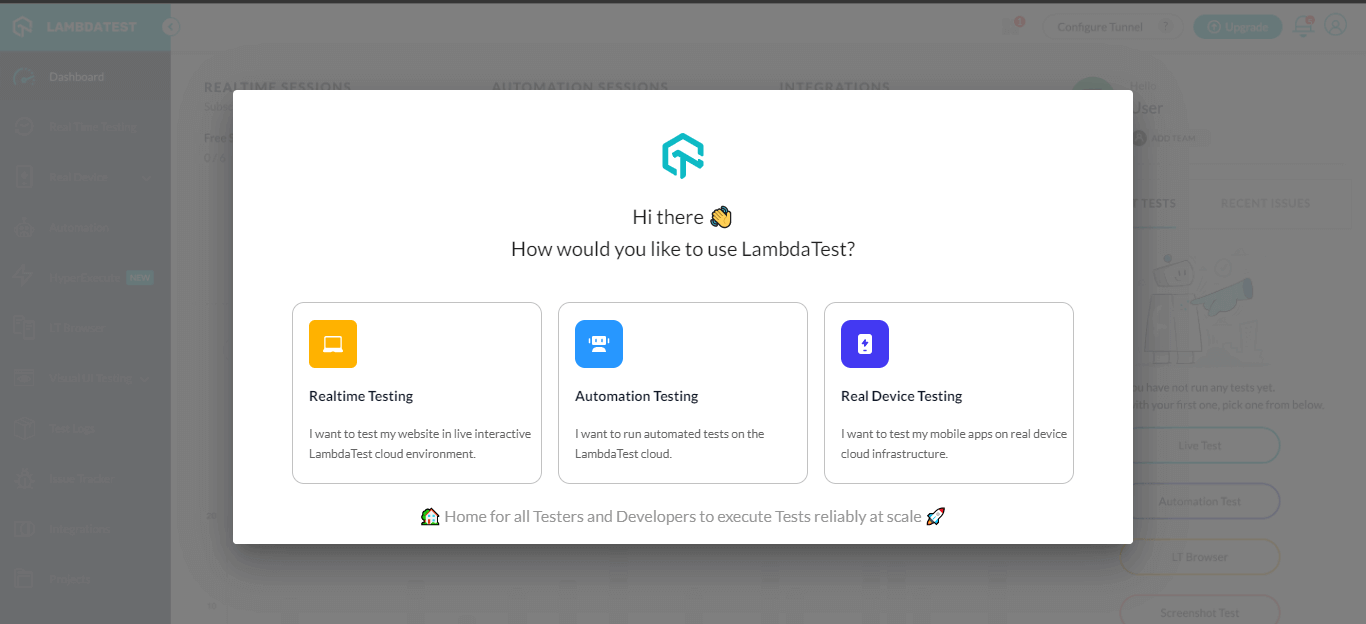
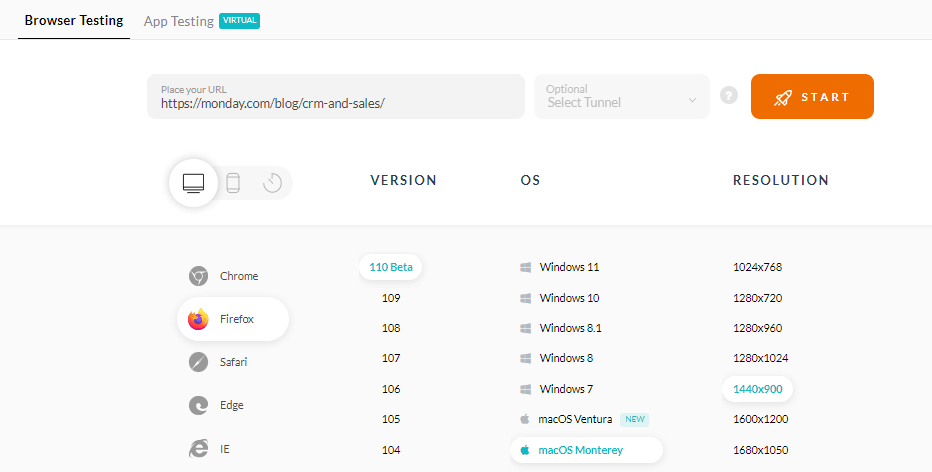
You will get a cloud-based machine launched which runs on the operating system and real browsers. Here, you can run a test by leveraging features like one-click bug logging, video recording of a test session, and others.

Automation Testing with LambdaTest
LambdaTest gives access to a large farm of mobile browsers and desktop environments to run automation tests using different automation testing frameworks like Selenium, Playwright, Appium, etc.
Follow these steps to perform an automation test.
- Log in to your LambdaTest account.
- Navigate to Automation > Builds from the left sidebar menu.
- Select any from the Demo Project or Configure Test Suite.
- Choose Configure Test Suite option, then choose the preferred automation tool or framework to run the grey box test.
- You can now configure the test and start testing your software application.
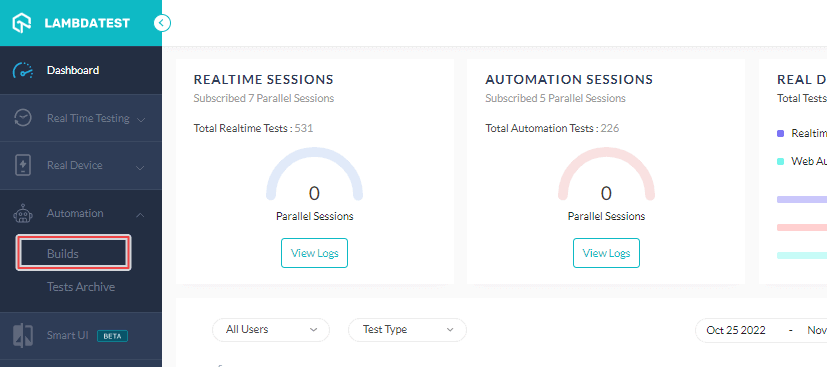
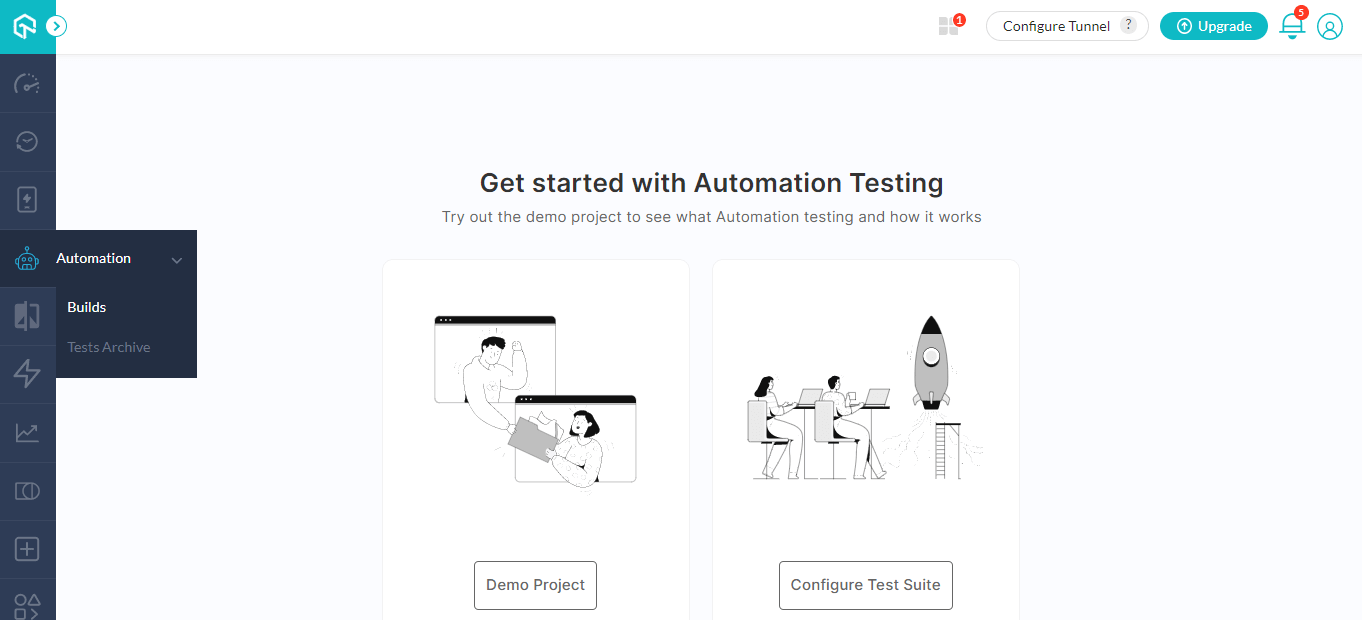
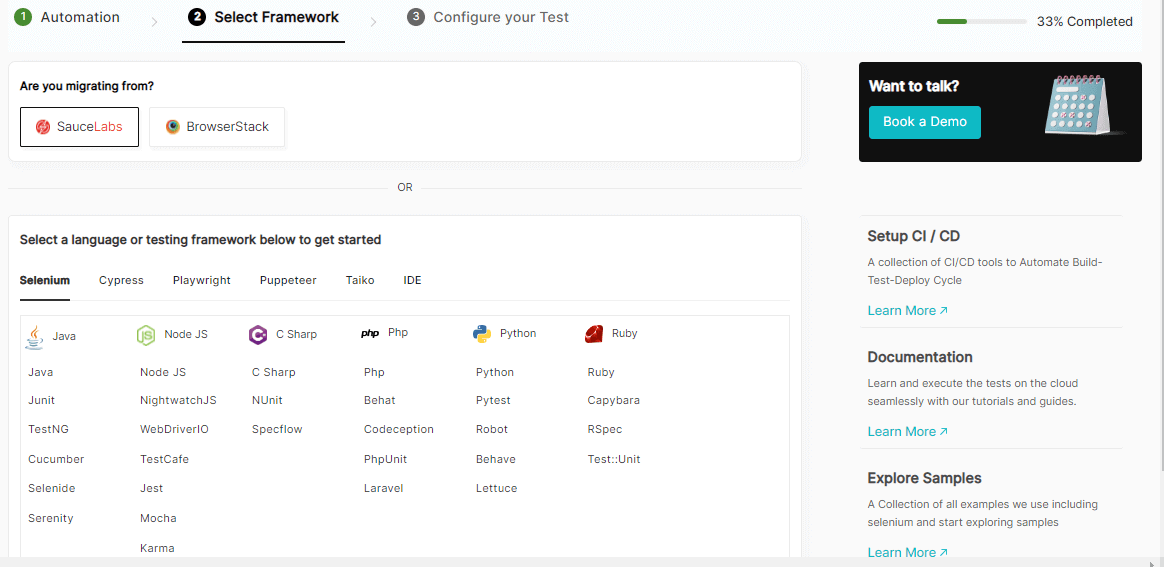
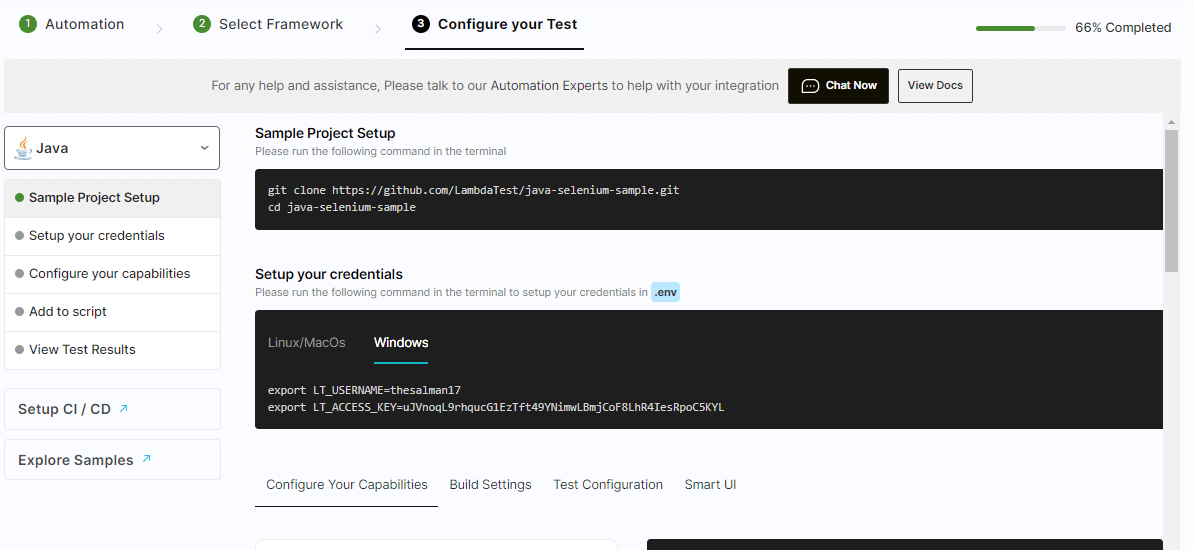
To get started with automation testing, please check LambdaTest documentation.
Challenges of Grey Box Testing
Grey box testing is an important part of developing software applications that ensure their functionality. However, it has some challenges that the testers and developers should know to overcome.
- When software application components under test fail due to errors or bugs, the continuing operation has to be terminated.
- Grey box tests can be performed by having limited knowledge of the internal functions of the component of the software application being tested. Therefore, this may create difficulty in finding all potential defects.
- Creating and executing grey box test cases is one of the great challenges. The reason is that testers need to understand the interaction between the software application’s back-end and front-end components.
- Maintenance efforts by the testers are often required. The reason is a change in the software application’s architecture or design, which directly impacts the test cases and execution of the test.
- Grey box tests require access to the source code or specialized testing tools for their success. However, such access may not be available to all testers.
Best Practices of Grey Box Testing
To overcome the challenges in grey box testing and optimize its execution in software application development, it is important to follow its best practices.
- You should strive to gain a deep understanding of the software application under test, like its data flow, architecture, and back-end and front-end components. Such knowledge will help to create effective test cases and identify potential defects.
- You should leverage automation tools in performing grey box tests. It will save time in testing by executing repetitive test cases.
- It is always recommended to combine testing techniques like functional testing, regression testing, and exploratory testing in grey box tests. It will ensure a comprehensive test of the software application with early detection of bugs.
Conclusion
Grey box testing is one of the most beneficial software testing types that combines white and black box testing. With this, testers can access the software applications' internal workings without becoming overly biased or subjective in their testing approach.
In a nutshell, it should be noted that grey box tests are one of the most effective testing techniques that help ensure the quality and reliability of software applications. It gives a complete view of a software application’s functionality and performance. This allows us to identify and fix any potential issues before releasing the software application in the market.
Frequently asked questions
- General
Author's Profile

Nazneen Ahmad
Nazneen Ahmad is an experienced technical writer with over five years of experience in the software development and testing field. As a freelancer, she has worked on various projects to create technical documentation, user manuals, training materials, and other SEO-optimized content in various domains, including IT, healthcare, finance, and education. You can also follow her on Twitter.
Reviewer's Profile

Salman Khan
Salman works as a Digital Marketing Manager at LambdaTest. With over four years in the software testing domain, he brings a wealth of experience to his role of reviewing blogs, learning hubs, product updates, and documentation write-ups. Holding a Master's degree (M.Tech) in Computer Science, Salman's expertise extends to various areas including web development, software testing (including automation testing and mobile app testing), CSS, and more.
Did you find this page helpful?
More Hubs
Try LambdaTest Now !!
Get 100 minutes of automation test minutes FREE!!

 Christmas Deal is on: Save 25% off on select annual plans for 1st year.
Christmas Deal is on: Save 25% off on select annual plans for 1st year.








